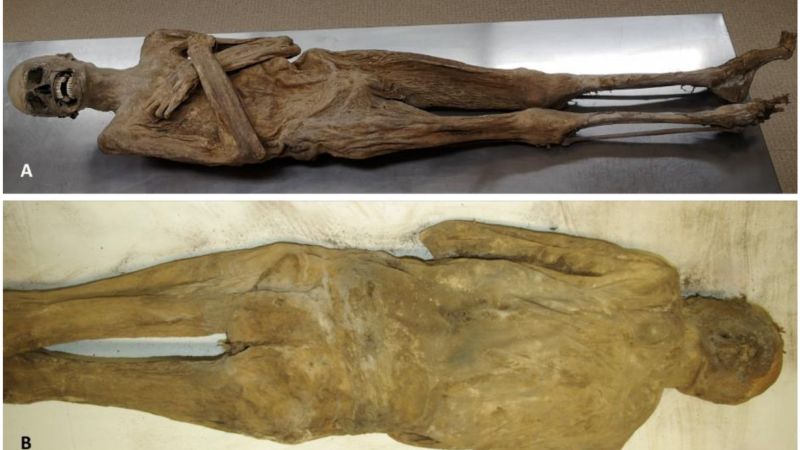Stored in a quaint church crypt located in a secluded Alpine village, a remarkable set of human remains has intrigued both locals and scientists for centuries. The tails surrounding these unusually well-preserved remains, thought to belong to an 18th-century clergyman, have long been a subject of both fascination and speculation. Local folklore suggested that the body was that of a clergyman who perished due to an infectious disease and had been transferred to the crypt of St. Thomas am Blasenstein, which is situated in a village strategically located north of the Danube River in Austria. This intriguing narrative lays the foundation for ongoing research that seeks to uncover the truth behind the old tales.
The mysterious preservation of the corpses initially drew many pilgrims who believed the remains bestowed healing properties. However, recent discoveries have cast a different light on the matter. A capsule-shaped object discovered via an X-ray scan of the mummy indicates that the clergyman might not have died a natural death—implicating the possibility that he was poisoned. This new angle has spurred scientists to delve deeper into the secrets surrounding this enigmatic figure, dubbed the “air-dried chaplain.” A recent water leak in the crypt provided a unique opportunity for a state-of-the-art scientific analysis of the body during a renovation.
“The opportunity came when we took the mummy for a few months for examination with our specialized teams, including CT scans,” explained Andreas Nerlich, a professor of medicine at Ludwig-Maximilians University of Munich, who led the research. The interplay between time spent on the mummy and the renovations proved advantageous, allowing for a thorough examination and analysis of the remains.
Utilizing advanced techniques, including CT scanning, radiocarbon dating, and chemical analysis, the team confirmed the mummy’s identity while unraveling the unique process that preserved the body. Their findings were published in the journal *Frontiers in Medicine*, revealing astonishing details about the remains. Among the significant revelations was the discovery of the mummy’s abdominal and pelvic cavity, where the scientists found an unexpected mixture of materials, including wood chips from fir and spruce trees, linen, and hemp fibers.
“The discovery was unexpected, especially since the body walls remained intact,” remarked Nerlich. The researchers theorized the materials were likely inserted through the rectum, leading them to believe that this unconventional mixture contributed to the extended preservation of the mummy. They suggested that the wood chips and fabric might have bound water while the zinc chloride exerted a drying effect, thereby minimizing bacterial decomposition.
This embalming technique, which diverges from the well-known mummification practices of ancient Egypt, has not been documented in scientific literature before. Nerlich speculates that although this method was not recorded in popular texts of the time, it may have been common in the 18th century for preserving a corpse for exhibition or transport.
The insight gleaned from examining mummies is invaluable, according to Gino Caspari, an archaeologist and editor of “The Book of Mummies: An Introduction to the Realm of the Dead.” Caspari pointed out that mummified remains offer a wealth of knowledge on various subjects, from medical treatments for diseases to cultural attitudes surrounding death.
While the present analysis firmly establishes that the “air-dried chaplain” is not a naturally occurring mummy, further scrutiny is necessary to determine definitively whether zinc chloride was employed in the embalming process, noted Marco Samadelli, a senior researcher at the Institute for Mummy Studies in Bolzano, Italy. He added that traces of arsenic, another known embalming agent, were also discovered in the remains.
Ultimately, the research team determined that the mummified body belonged to Franz Xaver Sidler von Rosenegg, an aristocrat who became the parish vicar at St. Thomas am Blasenstein in the mid-18th century. Unfortunately, he died at the age of 37, during his tenure as the vicar. Though the local legends pointed to Sidler’s identity, no formal documentation existed to validate this claim—until now.
Radiocarbon dating situates his death between 1734 and 1780, and bodily analyses suggest he likely died between the ages of 30 and 50, further affirming the connections to Sidler. Additionally, chemical profiling of his bones indicated that his diet was quite affluent, primarily composed of grains and an ample amount of meat. Such dietary habits correspond to what would have been expected for a parish vicar living in a rural environment. Despite generally good health, the study found that Sidler likely faced food shortages toward the end of his life, potentially exacerbated by the War of Austrian Succession.
The researchers concluded that the vicar was not poisoned, as initially speculated; rather, it appears he suffered from chronic tuberculosis, leading to his demise from acute pulmonary hemorrhage. Among the findings was a small glass sphere, possibly part of a set of rosary beads trapped in the embalming materials—a bullet-shaped object reminiscent



